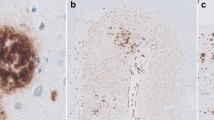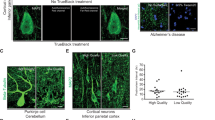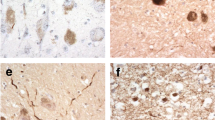Summary
The extent of amyloid deposition within the cerebellum and the cerebral cortex was assessed and compared, using anti-amyloid protein (A4) immunostaining and a novel methenamine silver method, in 20 patients aged between 60 and 77 years with Alzheimer's disease (AD), 29 patients aged between 13 and 71 years with Down's syndrome (DS), 26 demented patients with disorders other than AD and DS and in 20 non-demented elderly individuals of age range 60–102 years. In AD, amyloid deposits were noted in the cerebellar cortex in 90% of patients and in the meningeal vessels of the cerebellum in 80% of patients. In DS, amyloid deposits were seen in the cerebellar cortex in 82% of patients over 30 years of age and was universal in patients over 50 years of age. Overall, in DS, amyloid deposits were present in the meningeal vessels of the cerebellum in 79% of patients, but were present in 94% of those patients over 50 years of age. The sites of amyloid deposition in the cerebellar cortex were (poorly) detected by lectin histochemistry (Concanavalin A binding) in only 40% of patients with AD and 43% of all patients with DS (69% of those over 50 years of age). No amyloid deposits were seen in either the cerebellar cortex or its meningeal vessels in any of the 20 non-demented elderly individuals nor in any of the non-Alzheimer demented patients. The cerebellar amyloid deposits were never associated with a neuritic change [i.e. as characterised by the presence of (taupositive) paired helical filaments (PHF)] and neurofibrillary tangles were seen only in a few cells of the dentate nucleus in a single patient with AD and in three of the elderly DS patients. Amyloid deposits were numerous in the cerebral cortex of all patients with AD and in all, except the 13-year-old patient, with DS. In all the AD patients and in most of the DS patients over 30 years of age, many of the cerebral cortical amyloid deposits were associated with neurites and were strongly recognised by lectin histochemistry. Amyloid deposits were present within the meningeal vessels of the cerebral cortex in 75% patients with AD and 72% of patients, over 30 years of age, with DS (82% of those over 50 years of age). These data indicate that the process of amyloidosis in AD and in elderly DS patients is not restricted to the cerebral cortex and may affect other grey matter regions, particularly the cerebellum. However, it seems to be only in the cerebral cortex that such deposits are widely associated with a ‘reactive’ neuritic (PHF) change and an accumulation of saccharide. It is probably these latter alterations that mark the process of neuronal (neurofibrillary) degeneration that leads to functional deficits.
Similar content being viewed by others
References
Allsop D, Landon M, Kidd M, Lowe JS, Reynolds GP, Gardner A (1986) Monoclonal antibodies raised against a subsequence of senile plaque core protein react with plaque cores, plaque periphery and cerebrovascular amyloid in Alzheimer's disease. Neurosci Lett 68:252–256
Barcikowska M, Wisniewski HM, Bancher C, Grundke-Iqbal I (1989) About the presence of paired helical filaments in dystrophic neurites participating in the plaque formation. Acta Neuropathol 78:225–231
Coria F, Castano ME, Frangione B (1987) Brain amyloid in normal ageing and cerebral angiopathy is antigenically related to Zlzheimer's disease β protein. Am J Pathol 129:422–428
Cross RB (1982) Demonstration of neurofibrillary tangles in paraffin section — a quick and simple method using Palmgren's technique. Med Lab Sci 39:67–69
Davies L, Wolska B, Hilbich C, Multhaup G, Martins R, Simms G, Beyreuther K, Masters CL (1988) A4 amyloid protein deposition and the diagnosis of Alzheimer's disease: prevalence in aged brains determined by immunocytochemistry compared with conventional neuropathologic techniques. Neurology 38:1688–1693
Dayan AD (1970) Quantitative histological studies in the aged human brain. I. senile plaques and neurofibrillary tangles in ‘normal’ patients. Acta Neuropathol (Berl) 16:85–94
Glenner GG (1983) Alzheimer's disease: the commonest form of amyloidosis. Arch Pathol Lab Med 107:281–282
Glenner GG (1987) Amyloidosis in Alzheimer's disease and Down's syndrome. In: Davies P, Finch CE (eds) Banbury Report 27, Molecular neuropathology of ageing. Cold Spring Harbor Laboratory, Cold Spring Harbor, pp 253–263
Glenner GG, Wong CW (1984) Alzheimer's disease: initial report of the purification and characterization of a novel cerebrovascular amyloid protein. Biochem Biophys Res Commun 120:885–890
Haga C, Yamaguchi I, Ikeda K, Kosaka K (1989) PAM modified methenamine silver stain for senile plaques: comparison with β protein immunostaining. Dementia 3:417–422
Haga C, Ikeda K, Kosaka K, Izumiyama Y, Oyanagi S (1989) Light and electron microscopic study of plaque-like structures in Alzheimer type dementia. Dementia 3:85–90
Hardy JA, Mann DMA, Wester P, Winblad B (1986) An integrative hypothesis concerning the pathogenesis and progression of Alzheimer's disease. Neurobiol Ageing 7:489–502
Ihara Y (1988) Massive somatodendritic sprouting of cortical neurones in Alzheimer's disease. Brain Res 459:138–144
Ihara Y, Nukina N, Miura R, Ogawara M (1986) Phosphorylated tau protein is integrated into paired helical filaments in Alzheimer's disease. J Biochem 99:1807–1810
Ikeda S-I, Allsop D, Glenner GG (1989) The morphology and distribution of plaque and related deposits in the brains of Alzheimer's disease and control cases: an immunohistochemical study using amyloid β protein antibody. Lab Invest 60:113–122
Ikeda S-I, Yanagisawa N, Allsop D, Glenner GG (1989) Evidence of amyloid β protein immunoreactive early plaque lesions in Down's syndrome brains. Lab Invest 61:133–137
Joachim CL, Duffy LK, Morris JH, Selkoe DJ (1988) Protein chemical and immunocytochemical studies of meningovascular β-amyloid protein in Alzheimer's disease and normal ageing. Brain Res 474:100–111
Joachim CL, Morris JH, Selkoe DJ (1989) Diffuse amyloid plaques occur commonly in the cerebellum in Alzheimer's disease. Am J Pathol 135:309–319
Kang J, Lemaire H-G, Unterbeck A, Salbaum JM, Masters CL, Grzeschik K-H, Multhaup G, Beyreuther K, Muller-Hill B (1987) The precursor of Alzheimer's disease amyloid A4 protein resembles a cell surface receptor. Nature 325:733–736
Kitamoto T, Ogomori K, Tateishi J, Prusiner SB (1987) Formic acid pretreatment enhances immunostaining of cerebral and systemic amyloids. Lab Invest 57:230–236
Mann DMA (1985) The neuropathology of Alzheimer's disease: a review with pathogenetic, aetiological and therapeutic considerations. Mech Ageing Dev 31:213–255
Mann DMA (1988) The pathological association between Down's syndrome and Alzheimer's disease. Mech Ageing Dev 43:99–136
Mann DMA (1988) Alzheimer's disease and Down's syndrome. Histopathology 13:125–137
Mann DMA, Esiri MM (1989) The pattern of acquisition of plaques and tangles in the brains of patients under 50 years of age with Down's syndrome. J Neurol Sci 89:169–179
Mann DMA, Jones D (1990) Deposition of amyloid (A4) protein in the brains of persons with dementing disorders other than Alzheimer's disease and Down's syndrome. Neurosci Lett 109:68–75
Mann DMA, Tucker CM, Yates PO (1987) The topographic distribution of plaques and tangles in the brains of non-demented persons of different ages. Neuropathol Appl Neurobiol 13:123–139
Mann DMA, Brown A, Prinja D, Davies CA, Landon M, Masters CL, Beyreuther K (1989) An analysis of the morphology of senile plaques in Down's syndrome patients of different ages using immunocytochemical and lectin histochemical techniques. Neuropathol Appl Neurobiol 15:317–329
Mann DMA, Brown A, Prinja D, Davies CA (1990) Immunocytochemical and lectin histochemical studies of senile plaques in the brains of non-demented persons of different ages. Neuropathol Appl Neurobiol 16:17–25
Marcyniuk B, Mann DMA, Yates PO (1986) The topography of cell loss from the locus caeruleus in Alzheimer's disease. J Neurol Sci 76:335–345
Marcyniuk B, Mann DMA, Yates PO (1987) Topography of nerve cell loss from the locus caeruleus in middle aged persons with Down's syndrome. J Neurol Sci 83:15–24
Masters CL, Simms GL, Weinmann NA, Multhaup G, McDonald BL, Beyreuther K (1985) Amyloid plaque core protein in Alzheimer's disease and Down's syndrome. Proc Natl Acad Sci USA 85:4245–4249
Mastaglia FL, Masters CL, Beyreuther K, Kakulas BA (1988) Deposition of amyloid (A4) protein in the cerebral cortex in Parkinson's disease (PD). Alzheimer Dis Assoc Disord 2: 245
Matsuyama H, Nakamura S (1978) Senile changes in the brain in the Japanese; incidences of Alzheimer neurofibrillary change and senile plaques. In: Katzman R, Terry RD, Bick KL (eds) Alzheimer's disease: senile dementia and related disorders. Raven Press, New York, pp 287–297
Mita S, Schon EA, Herbert J (1989) Widespread expression of amyloid β protein precursor gene in rat brain. Am J Pathol 134:1253–1261
Ogomori K, Kitamoto T, Tateishi J, Sato Y, Suetsugu M, Abe M (1989) β protein amyloid is widely distributed in the central nervous system of patients with Alzheimer's disease. Am J Pathol 134:243–251
Oliver C, Holland AJ (1986) Down's syndrome and Alzheimer's disease — A review. Psychol Med 16:307–322
Palmert MR, Golde TE, Cohen ML, Kovacs D, Tanzi RE, Gusella JF, Usiak MF, Younkin LM, Younkin SG (1988) Amyloid protein precursor messenger RNAs: differential expression in Alzheimer's disease. Science 241:1080–1083
Pro JD, Smith CH, Sumi SM (1982) Presenile Alzheimer's disease: amyloid plaques in the cerebellum. Neurology 30:820–825
Selkoe DJ (1989) Molecular pathology of amyloidogenic proteins and the role of vascular amyloidosis in Alzheimer's disease. Neurobiol Ageing 10:387–395
Selkoe DJ, Podlisny MB, Joachim CL, Vickers EA, Lee G, Fritz C, Oldersdorf T (1988) β-amyloid precursor protein of Alzheimer's disease occurs as 110- to 135-kilodalton membrane associated proteins in neural and non-neural tissues. Proc Natl Acad Sci USA 85:7341–7345
Shivers BD, Hilbich C, Multhaup G, Salbaum JM, Beyreuther K, Seeburg PH (1988) Alzheimer's disease amyloidogenic glycoprotein: expression pattern in rat brain suggests a role in cell contact. EMBO J 7:1365–1370
Tagliavini F, Giaccone G, Frangione B, Bugiani O (1988) Preamyloid deposits in the cerebral cortex of patients with Alzheimer's disease and non-demented individuals. Neurosci Lett 93:191–196
Tan N, Mastaglia FL, Masters CL, Beyreuther K, Kakulas BA (1988) Amyloid (A4) protein deposition in brain in progressive supranuclear palsy (PSP). Alzheimer Dis Assoc Disord 2: 264
Tomlinson BE, Blessed G, Roth M (1968) Observations on the brains of non-demented elderly persons. J Neurol Sci 7:331–356
Uchida Y, Tomonaga M (1989) Neuronotrophic action of Alzheimer's disease brain extract is due to loss of inhibitory factors for survival and neurite formation of cerebral cortical neurones. Brain Res 481:190–193
Uchida Y, Ihara Y, Tomonaga M (1988) Alzheimer's disease brain extract stimulates the survival of cerebral cortical neurones from neonatal rats. Biochem Biophys Res Commun 150:1263–1267
Whalley LJ (1982) The dementia of Down's syndrome and its relevance to aetiological studies of Alzheimer's disease. Ann NY Acad Sci 396:39–53
Wisniewski HM, Rabe A (1986) Discrepancy between Alzheimer type neuropathology and dementia in persons with Down's syndrome. Ann NY Acad Sci 477:247–259
Wisniewski HM, Terry RD (1973) Re-examination of the pathogenesis of the senile plaque. Prog Neuropathol 2:1–26
Wisniewski HM, Bancher C, Barcikowska M, Wen GY, Currie J (1989) Spectrum of morphological appearance of amyloid deposits in Alzheimer's disease. Acta Neuropathol 78:337–347
Yamaguchi H, Hirai S, Morimatsu M, Shoji M, Ihara Y (1988) A variety type cerebral amyloid deposits in the brains of the Alzheimer type dementia demonstrated by β protein immunostaining. Acta Neuropathol 76:541–549
Yamaguchi H, Hirai S, Morimatsu M, Shoji M, Harigaya Y (1988) Diffuse type of senile plaque in the brains of Alzheimer type dementia. Acta Neuropathol 77:113–119
Yamaguchi H, Hirai S, Morimatsu M, Shoji M, Nakazato Y (1989) Diffuse type of senile plaques in the cerebellum of Alzheimer type dementia detected by β protein immunostaining. Acta Neuropathol 77:314–319
Author information
Authors and Affiliations
Additional information
Supported in part by the North Western Regional Health Authority
Rights and permissions
About this article
Cite this article
Mann, D.M.A., Jones, D., Prinja, D. et al. The prevalence of amyloid (A4) protein deposits within the cerebral and cerebellar cortex in Down's syndrome and Alzheimer's disease. Acta Neuropathol 80, 318–327 (1990). https://doi.org/10.1007/BF00294651
Received:
Revised:
Accepted:
Issue Date:
DOI: https://doi.org/10.1007/BF00294651




